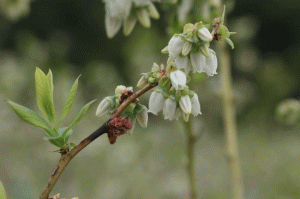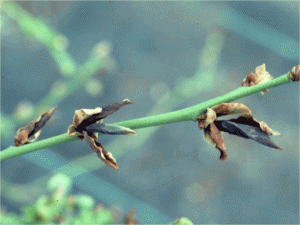- Blueberry Scorch Disease
- Phomopsis Twig Blight
- Blueberry Shock Virus
- Anthracnose
Blueberry bloom is progressing nicely and bee activity seems reasonably good. Our biggest enemies are wind and cold. Botrytis does not seem to be developing in blueberry fields and should not pose any risk in the next 7-days. Anthracnose is our biggest disease concern at this point. Hopefully all conventional growers will have made one application of Ziram and will be looking at an application of Abound next week.
Blueberry Scorch Disease
Symptoms of the Blueberry Scorch Virus will begin to appear this week and next.
Begin scouting for development of scorch at this time and flag all suspect bushes. Symptoms are easily seen during bloom and you should be aware that this disease is present on your farm. If it is present, map the locations of infected bushes and flag these bushes. Mapping the locations will make it easy to monitor for the disease in future years. Any scorch infected bushes should cut back and removed. Aphid scouting and management should be made high priority in fields with infected plants.
Phomopsis Twig Blight
Phomopsis Twig Blight is no longer active.
Fields with symptoms of this disease should be confirmed and targeted for management next season. Phomopsis can be recognized by dead cane tips that can be tracked down to a single point of origin such as an infected bud.
Blueberry Shock Virus
Blueberry Shock Virus has not been reported in New Jersey.
If you see symptoms resembling this disease contact Peter Oudemans right away so that it can be diagnosed
Anthracnose
For anthracnose management, the most critical period to begin is at early to midbloom. Initiating applications at this time have been demonstrated to be most effective. Choice of materials should be determined by efficacy. Our research has shown that Abound applied during bloom will reduce migration of the pathogen from its overwintering reservoir to the developing fruit. Other fungicides are effective at protecting the developing fruit. For susceptible cultivars such as Bluecrop apply Abound twice during bloom and once with Ziram, Captan or Omega. Subsequent fungicide applications should utilize protectant fungicides such as Abound, Captan, Omega or Ziram. It is my experience that Ziram provides a longer residual period and a 14-day interval is reasonable. Captan will require a 7-day interval. Fungicides such as Pristine or Switch are effective for protecting against Mummy, Botrytis and Anthracnose while Captevate can be used for Botrytis and Anthracnose.

Abound, Cabrio, Pristine Resistance!
Fungicides are subject to resistance if they are over used or improperly used. Some fungicides are considered high risk since a relatively simple genetic mutation in the fungus can lead to resistance. Other fungicides are considered low risk since it would require complex genetic changes for resistance to develop. The best strategy to reduce the chance of resistance is to use effective low-risk fungicides between applications of high-risk fungicides. In blueberry we have two fungicides that are considered high risk. These fungicides are related and this means resistance to one results in resistance to the other. It is critical therefore to never use these fungicides more than twice in a row and preferably only once. Abound and Pristine both contain a strobilurin fungicide as the active ingredient. Therefore these materials should not be used in succession in a spray program. The Table below gives some examples of spray regimes that may or may not select for resistance.
| Spray 1 | Spray 2 | Spray 3 | Spray 4 | Assessment |
| Abound | Pristine | Abound | Pristine | Very bad all high risk with the same mode of action |
| Abound | Pristine | Ziram | Abound | Bad, still heavy emphasis on high risk materials |
| Abound or Pristine | Ziram | Abound or Pristine | Ziram | Best, high risk materials separated by low-risk |





